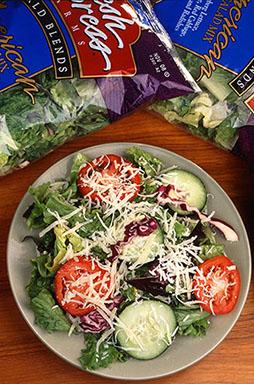Taking a Holistic Approach to Food Safety

Researchers Add Pulsed Light to an Arsenal of Tools to Decontaminate Foods
For over 20 years, scientists have been trying to develop individual technologies and treatments to kill pathogens on the surface of foods with limited success. The food processing industry has many health and safety protocols for processing foods, but once a product is packaged, it can be harder to control what happens.
“Post-processing contamination is a major contributor to foodborne illness outbreaks,” said Sudarsan Mukhopadhyay, a chemical engineer at the Agricultural Research Service’s (ARS) Food Safety and Intervention Technologies Research Unit in Wyndmoor, PA. “Once packaged in bags, treatment options are very limited.”
Now, scientists from ARS are tackling the problem from another angle. Mukhopadhyay and research partners Xuetong Fan, food technologist, and Tony Jin, packaging specialist, are taking a holistic approach to the problem, by using different interventions at the same time.
Most previous attempts to eliminate pathogens were either not effective enough; altered the taste, aroma, or appearance of the product; or reduced the product’s nutritional quality. “The aim of this project was to increase antimicrobial efficacy while minimizing loss of quality by combining individual treatments and technologies,” Fan said. “It is better to apply treatment combinations simultaneously, rather than sequentially, so that they can be easily adopted by the industry.”
“We hope to achieve synergistic effects against foodborne pathogens,” Fan said. “Together, the combinations will achieve a greater reduction of human pathogens than the sum of individual treatments applied separately.”
One example, is the use of pulsed light. Many packaging films can let in light, including germicidal ultraviolet (UV) light. UV light could be combined with packaging that contains airborne antimicrobials (nano- and micrometer-sized droplets of antimicrobials that can find pathogens in crevices, stem scars, and other rough surfaces of fresh produce items) and cold plasma treatment.
In this type of treatment, food is exposed to high intensity light in short, powerful pulses. The broad spectrum of the light, from UV to near infrared, neutralizes microorganisms, including bacteria, spores, yeasts, and fungi from food surfaces. “Although packaging film slightly reduces UV light transmission to food surfaces, the effectiveness of pulsed light is not significantly affected,” Jin said.
“The UV domain of pulsed light causes photochemical damage and changes the shape of DNA strands in a pathogen’s cells,” Mukhopadhyay explained. “This disrupts critical metabolic operations and leads to the death of the pathogen.”
Pulsed light inactivates pathogens; extends a product’s shelf life; and has only minimal effects on the product’s taste, aroma, and appearance. It has been approved by the U.S. Food and Drug Administration for decontamination of foods and contact surfaces.
“This newly-developed in-package high-intensity pulsed light treatment is a safe and effective intervention technology,” Mukhopadhyay said. “Pulsed light can penetrate plastic packaging and kill the pathogens that live on the surface of produce. It is an economical, low-cost, sustainable technology that requires no heat, water, or any harmful disinfectant chemicals.” – By Scott Elliott, ARS Office of Communications.
You May Also Like

